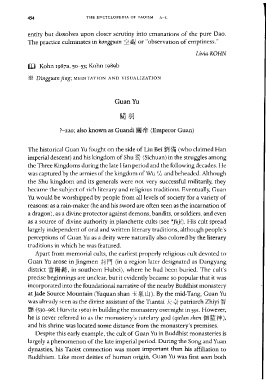Page 494 - The Encyclopedia of Taoism v1_A-L
P. 494
454 THE ENCYCLOPEDIA OF TAOISM A-L
entity but dissolves upon closer scrutiny into emanations of the pure Dao.
The practice culminates in kongguan ':'2 Wl or "observation of emptiness."'
LiviaKOHN
* Dingguanjing; MEDITATION AND VISUALIZATION
Guan Yu
?-220; also known as Guandi I»ItJ 1ff (Emperor Guan)
The historical Guan Yu fought on the side of Liu Bei WIJ fjij (who claimed Han
imperial descent) and his kingdom of Shu fu] (Sichuan) in the struggles among
the Three Kingdoms during the late Han period and the following decades. He
was captured by the armies of the kingdom of Wu Ij1 and beheaded. Although
the Shu kingdom and its generals were not very successful militarily, they
became the subject of rich literary and religious traditions. Eventually, Guan
Yu would be worshipped by people from all levels of society for a variety of
reasons: as a rain-maker (he and his sword are often seen as the incarnation of
a dragon), as a divine protector against demons, bandits, or soldiers, and even
as a source of divine authority in planchette cults (see *foji). His cult spread
largely independent of oral and written literary traditions, although people's
perceptions of Guan Yu as a deity were naturally also colared by the literary
traditions in which he was featured.
Apart from memorial cults, the earliest properly religious cult devoted to
Guan Yu arose in Jingmen AA F~ (in a region later designated as Dangyang
district 'I~~, in southern Hubei), where he had been buried. The cult's
precise beginnings are unclear, but it evidently became so popular that it was
incorporated into the foundational narrative of the nearby Buddhist monastery
at Jade Source Mountain (Yuquan shan +. ¥R L1J). By the mid-Tang, Guan Yu
was already seen as the divine assistant of the Tiantai A '~1: patriarch Zhiyi ~
IiJj (530-98; Hurvitz I962) in building the monastery overnight in 59!. However,
he is never referred to as the monastery's tutelary god (qielan shen fJlU i?f.;f$),
and his shrine was located some distance from the monastery's premises.
Despite this early example, the cult of Guan Yu in Buddhist monasteries is
largely a phenomenon of the late imperial period. During the Song and Yuan
dynasties, his Taoist connection was more important than his affiliation to
Buddhism. Like most deities of human origin, Guan Yu was first seen both

